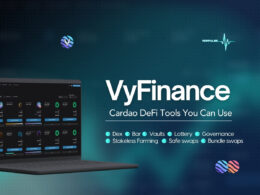The Q1 of 2023 was a turbulent period in the global economy. In the last three months, the world has witnessed the fall of multiple banks, bringing the global banking sector to the brink of collapse. As the banking sector faces turmoil, some see this as an opportunity for alternative financial systems, such as cryptocurrencies. At the same time, Cardano made an incredible amount of progress when it came to scaling and governance.
In this summary, we will delve into the most significant events surrounding Cardano, explore the broader crypto ecosystem, and investigate the major events in the global economy and their impact.
Q1 2023: A Tumultuous Quarter for Banks and a Boom for Cryptocurrencies
The first quarter of 2023 has been a wild ride for the global economy, as multiple banks have tumbled into crisis, threatening the financial sector’s stability.
Silicon Valley Bank was one of the most prominent casualties of the recent economic turbulence. A key player in the tech startup ecosystem, the bank’s downfall was attributed to rising interest rates that exposed its over-leveraged balance sheet.
Fed Raises the Interest rate further
In the midst of ongoing difficulties within the banking industry, the Federal Reserve raised interest rates once again.
The Federal Reserve’s decision to raise interest rates in the wake of bank failures raises questions about the delicate balance between managing inflation and maintaining stability in the banking sector. While higher interest rates are widely accepted as an effective tool for controlling inflation, they can also put significant strain on banks, particularly those already struggling to remain afloat.
Balaji’s Bitcoin Bet: A Bold Move Amidst Economic Uncertainty
Amidst the turbulence in the financial markets, Balaji Srinivasan, the former Coinbase CTO, has made a daring move. Balaji believes hyperinflation is already happening and has placed a million-dollar bet on Bitcoin’s price exceeding $1 million within 90 days.
This audacious wager showcases his faith in Bitcoin as a hedge against the unstable economic climate resulting from factors like the Fed’s interest rate hike and its impact on banks like Silicon Valley Bank.
The Context Of Balaji’s Bet
Balaji’s Bitcoin bet comes when the world is grappling with economic uncertainty, making it an even more intriguing proposition.
He contends that cryptocurrencies, particularly Bitcoin, have the potential to serve as a store of value and a medium of exchange in the face of economic instability. By placing such a bold bet, Balaji aims to demonstrate the resilience and potential of cryptocurrencies as a viable alternative to traditional financial systems that are vulnerable to macroeconomic shifts, such as the current struggles faced by banks like Silicon Valley Bank.
Bitcoin Emerged As The Top-Performing Asset In Q1/2023
As the traditional banking sector faces unprecedented challenges, the strong performance of Bitcoin during this time showcases its resilience in the face of economic uncertainty.
Bitcoin concluded the first fiscal quarter with its most remarkable three-month performance in almost two years, with an estimated 70% price increase.
Bitcoin has significantly outperformed the S&P 500, which currently boasts a 5.5% return in Q1 2023. Furthermore, Bitcoin has outpaced the Nasdaq 100 by more than threefold, as the latter has only experienced a 19% price gain in Q1 2023.
Tezos Introduced Enshrined Roll-ups
Tezos has recently released enshrined roll-ups, achieving massive scale while preserving decentralization. This innovative technology utilizes the advantages of roll-ups without the disadvantages of Layer 2 scaling, thus presenting a challenge to Ethereum to keep up with the rapid advancements in the blockchain space.
The introduction of enshrined roll-ups showcases Tezos’s capability to develop scalable blockchains that can potentially outperform Ethereum. Enshrined Roll-ups are a native part of Tezos’s consensus layer, providing benefits such as no admin keys, no unusual tokenomics, no permissioned elements, and no KYC.
They offer perfect interoperability and composability, which addresses the user experience problem that has plagued L2 scaling solutions.
Polygon launched the zkEVM Mainnet
Polygon’s highly anticipated zkEVM mainnet has officially gone live, marking a significant milestone for the blockchain platform. Ethereum co-founder Vitalik Buterin celebrated the launch by sending the first transaction on the network.
Cardano’s Milkomeda Launches EVM Rollup
Cardano’s Milkomeda EVM layer is launching a feature that will allow every Cardano user to use EVM contracts directly from any Cardano wallet, using only ADA as the transaction currency. This move will make Cardano one of the largest EVM chains by user count and the largest EVM chain with fully operational staking rewards. Milkomeda is enabling staking rewards for all EVM users, providing an incentive for developers to build on the Cardano platform.
Milkomeda is also developing a cross-chain bridge that will allow users to transfer assets and data between Cardano and Ethereum, utilizing smart contracts for the transfer of tokens and data, as well as the execution of decentralized applications (dApps) across both platforms.
Connecting Cardano to Ethereum will enable developers to access a larger pool of resources and tools, as well as a broader user base. However, there are also risks associated with cross-chain interoperability, including the potential for security breaches and the risk that smart contracts could behave differently on another platform.
The Implications of zkEVM Mainnet for Ethereum’s Scalability
The launch of Polygon’s zkEVM mainnet is a notable achievement in the pursuit of scalable blockchain solutions. It demonstrates the potential of zk technology in addressing critical issues such as scalability. The successful implementation of Polygon’s zkEVM mainnet serves as an example of innovative solutions that can transform the industry and pave the way for the broader adoption of blockchain technology.
Dynamic P2P Networking Arrived on Cardano
Cardano introduced dynamic peer-to-peer (P2P) networking with the release of node version 1.35.61. This exciting development represents a significant step forward for the Cardano blockchain, further enhancing its capabilities and laying the groundwork for improved network decentralization, performance, and efficiency.
By enabling nodes to discover and connect with peers automatically, the new P2P system will enhance the overall network’s resiliency, reduce reliance on centralized components, and improve overall performance.
The implementation of dynamic P2P networking brings the Cardano ecosystem closer to fulfilling its vision of a truly decentralized and scalable blockchain platform.
The Hydra Head Went Live on Cardano Mainnet
The IOG team is making steady progress when it comes to Hydra development. Recently the development team ran a demo version of the hydra head on the Cardano mainnet.
The Hydra family of protocols, with its first member, Hydra Head, lays the groundwork for advanced deployment situations.
If you want to try out the Hydra Demo App go to: https://hydraw.ncoding.at/
IOG is already collaborating with MLabs to create a reference implementation of an auction using Hydra protocols. This partnership aims to develop further and optimize the functionality of Hydra, allowing it to be leveraged in real-world scenarios. For details go here.
Additionally, IOG is working with Obsidian Systems to drive the development of use cases based on the Hydra Head protocol, such as Hydra for Payments. This collaboration aims to bring Hydra’s scalability solutions to payment systems, which slow transaction speeds and high costs have traditionally hampered. For details go here.
The development of Hydra and its related protocols is a significant milestone for Cardano, with the potential to revolutionize the blockchain industry. These collaborations and initiatives are set to accelerate the development of this solution and ultimately help Cardano maintain its position as a leading blockchain platform.
Conclusion
The first quarter of 2023 was eventful and turbulent; it has also provided a glimpse into the future of finance.
As the traditional financial infrastructure continues to be challenged, we are likely to see a rise in decentralized and transparent financial systems.
Whether this will ultimately lead to a more just and equitable financial system remains to be seen, but it is clear that we are on the cusp of a major transformation in the way we think about money and finance.
References
https://www.nytimes.com/live/2023/03/22/business/fed-interest-rates
https://iohk.io/en/blog/posts/2023/01/20/implementing-auction-projects-using-hydra-1/
https://twitter.com/InputOutputHK/status/1641789027073261569?s=20











